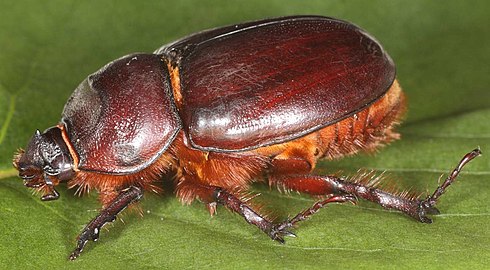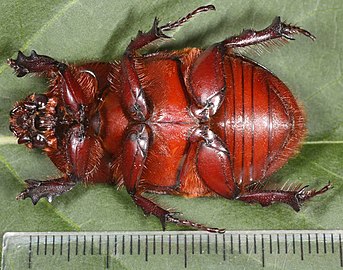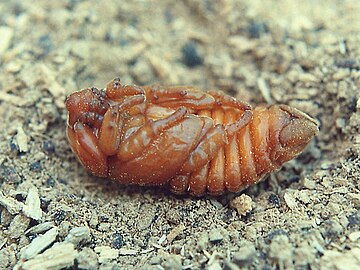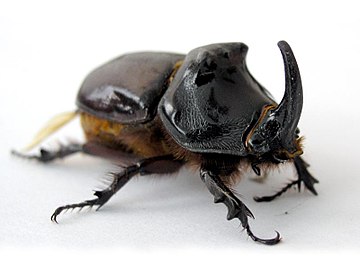414:
66:
402:
491:
479:
48:
31:
503:
515:
468:
The adult beetle emerges between the end of March to May, and lives for a few months until autumn. It occurs mainly during the months of June and July and is very active, flying at dusk and by night, attracted by lights. In this stage they do not feed, consuming only the reserves accumulated during
563:
The rhinoceros beetle lives on wood, and the large larvae can be found in rotting wood stumps and around sawdust. At the margin of its distribution, the beetle is often found in connection with sawmills and horse racing tracks.
777:
816:
896:
751:
939:
934:
578:
181:
413:
450:–4 in). The development period lasts 2 to 4 years. The adult’s size is influenced by the quality and abundance of food.
803:
465:
larvae. The female wasp lays one egg inside the beetle larva; when the egg hatches, the wasp larva will feed on the host.
790:
686:
478:
730:
929:
821:
592:
392:
species. The male's head is topped by a long curved horn (hence its common name), while the females have no horns.
743:
401:
65:
588:
667:
629:
691:
855:
160:
699:
574:
502:
388:
are slightly darker. The underside of the body and the legs are covered with long red hair. It is a
924:
490:
60:
860:
782:
842:
389:
847:
617:
Marek
Bunalski. Die Blatthomkäfer Mitteleuropas Coleoptera, Scarabaeoidea. Bratislava, 1999
829:
545:
738:
725:
596:
47:
30:
918:
177:
887:
557:
454:
127:
514:
808:
764:
661:
537:
541:
206:
652:
795:
712:
553:
433:
97:
77:
540:
region, excluding the
British Isles. It is the only representative of the
881:
646:
549:
385:
834:
678:
901:
756:
137:
436:), generally non-resinous. They can reach a length of 60–100 mm (
769:
381:
202:
117:
107:
87:
623:
717:
704:
627:
384:
are reddish brown with a glazed appearance, while the head and
432:
The larvae grow in decaying plants feeding on woody debris (
548:. It is widespread in the Mediterranean basin up to
871:
636:
8:
338:One of the largest beetles found in Europe,
624:
46:
29:
20:
610:
474:
397:
366:inches), with a maximum of 47 mm (
342:reach a length of 20–42 millimetres (
7:
744:396d70ed-6736-43a0-ae56-59f3590b798a
219:Oryctes nasicornis afghanistanicus
14:
513:
501:
489:
477:
412:
400:
327:Oryctes nasicornis turkestanicus
321:Oryctes nasicornis transcaspicus
64:
309:Oryctes nasicornis punctipennis
231:Oryctes nasicornis corniculatus
225:Oryctes nasicornis chersonensis
303:Oryctes nasicornis przevalskii
291:Oryctes nasicornis ondrejanus
249:Oryctes nasicornis hindenburgi
1:
317:Endrödi & Petrovitz, 1974
315:Oryctes nasicornis shiraticus
285:Oryctes nasicornis nasicornis
273:Oryctes nasicornis latipennis
305:Semenow & Medvedev, 1932
297:Oryctes nasicornis polonicus
255:Oryctes nasicornis holdhausi
940:Taxa named by Carl Linnaeus
419:With metric ruler for scale
267:Oryctes nasicornis kuntzeni
261:Oryctes nasicornis illigeri
205:belonging to the subfamily
24:European rhinoceros beetle
956:
593:Hillside Books, Canterbury
577:& G. Lachaume (2001).
484:Illustration of life cycle
237:Oryctes nasicornis edithae
193:European rhinoceros beetle
935:Beetles described in 1758
279:Oryctes nasicornis mariei
243:Oryctes nasicornis grypus
166:
159:
61:Scientific classification
59:
54:
45:
37:
28:
23:
589:The Beetles of the World
529:Distribution and habitat
233:Villa & Villa, 1833
873:Scarabaeus nasicornis
856:Paleobiology Database
461:) is a parasitoid of
739:Fauna Europaea (new)
201:) is a large flying
469:the larval stages.
459:Megascolia maculata
668:Oryctes nasicornis
638:Oryctes nasicornis
534:Oryctes nasicornis
463:O. nasicornis
390:sexually dimorphic
340:Oryctes nasicornis
198:Oryctes nasicornis
170:Oryctes nasicornis
152:O. nasicornis
41:. Male, side view
39:Oryctes nasicornis
930:Beetles of Europe
912:
911:
843:Open Tree of Life
630:Taxon identifiers
311:Motschulsky, 1860
275:Motschulsky, 1845
189:
188:
16:Species of beetle
947:
905:
904:
892:
891:
890:
864:
863:
851:
850:
838:
837:
825:
824:
812:
811:
809:NHMSYS0021164011
799:
798:
786:
785:
773:
772:
760:
759:
747:
746:
734:
733:
721:
720:
708:
707:
695:
694:
682:
681:
672:
671:
670:
657:
656:
655:
625:
618:
615:
600:
595:. Archived from
591:. Vol. 27.
544:family found in
517:
505:
493:
481:
449:
448:
444:
441:
416:
404:
379:
378:
374:
371:
365:
364:
360:
357:
351:
350:
346:
287:(Linnaeus, 1758)
172:
69:
68:
50:
33:
21:
955:
954:
950:
949:
948:
946:
945:
944:
915:
914:
913:
908:
900:
895:
886:
885:
880:
867:
859:
854:
846:
841:
833:
830:Observation.org
828:
820:
815:
807:
802:
794:
789:
781:
776:
768:
763:
755:
750:
742:
737:
729:
724:
716:
711:
703:
698:
690:
685:
677:
675:
666:
665:
660:
651:
650:
645:
632:
622:
621:
616:
612:
607:
575:R.-P. Dechambre
573:
570:
546:Northern Europe
531:
526:
525:
524:
521:
518:
509:
506:
497:
494:
485:
482:
446:
442:
439:
437:
430:
425:
424:
423:
420:
417:
408:
407:Female specimen
405:
380: in). The
376:
372:
369:
367:
362:
358:
355:
353:
348:
344:
343:
336:
281:(Bourgin, 1949)
245:(Illiger, 1803)
215:
185:
174:
168:
155:
63:
17:
12:
11:
5:
953:
951:
943:
942:
937:
932:
927:
917:
916:
910:
909:
907:
906:
893:
877:
875:
869:
868:
866:
865:
852:
839:
826:
813:
800:
787:
774:
761:
748:
735:
726:Fauna Europaea
722:
709:
696:
683:
673:
658:
642:
640:
634:
633:
628:
620:
619:
609:
608:
606:
603:
602:
601:
599:on 2010-08-06.
569:
566:
530:
527:
523:
522:
519:
512:
510:
507:
500:
498:
495:
488:
486:
483:
476:
473:
472:
471:
429:
426:
422:
421:
418:
411:
409:
406:
399:
396:
395:
394:
335:
332:
331:
330:
324:
318:
312:
306:
300:
294:
288:
282:
276:
270:
264:
258:
252:
246:
240:
234:
228:
222:
214:
211:
187:
186:
175:
164:
163:
157:
156:
149:
147:
143:
142:
135:
131:
130:
125:
121:
120:
115:
111:
110:
105:
101:
100:
95:
91:
90:
85:
81:
80:
75:
71:
70:
57:
56:
52:
51:
43:
42:
35:
34:
26:
25:
15:
13:
10:
9:
6:
4:
3:
2:
952:
941:
938:
936:
933:
931:
928:
926:
923:
922:
920:
903:
898:
894:
889:
883:
879:
878:
876:
874:
870:
862:
857:
853:
849:
844:
840:
836:
831:
827:
823:
818:
814:
810:
805:
801:
797:
792:
788:
784:
779:
775:
771:
766:
762:
758:
753:
749:
745:
740:
736:
732:
727:
723:
719:
714:
710:
706:
701:
697:
693:
688:
684:
680:
674:
669:
663:
659:
654:
648:
644:
643:
641:
639:
635:
631:
626:
614:
611:
604:
598:
594:
590:
586:
585:
581:
576:
572:
571:
567:
565:
561:
559:
555:
551:
547:
543:
539:
536:inhabits the
535:
528:
516:
511:
504:
499:
492:
487:
480:
475:
470:
466:
464:
460:
456:
451:
435:
427:
415:
410:
403:
398:
393:
391:
387:
383:
341:
333:
328:
325:
323:Endrödi, 1938
322:
319:
316:
313:
310:
307:
304:
301:
298:
295:
292:
289:
286:
283:
280:
277:
274:
271:
268:
265:
262:
259:
256:
253:
250:
247:
244:
241:
239:Endrödi, 1938
238:
235:
232:
229:
226:
223:
221:Endrödi, 1938
220:
217:
216:
212:
210:
208:
204:
200:
199:
194:
183:
179:
173:
171:
165:
162:
161:Binomial name
158:
154:
153:
148:
145:
144:
141:
140:
136:
133:
132:
129:
126:
123:
122:
119:
116:
113:
112:
109:
106:
103:
102:
99:
96:
93:
92:
89:
86:
83:
82:
79:
76:
73:
72:
67:
62:
58:
53:
49:
44:
40:
36:
32:
27:
22:
19:
872:
637:
613:
597:the original
584:(Dynastidae)
583:
579:
562:
558:North Africa
533:
532:
467:
462:
458:
455:mammoth wasp
452:
431:
339:
337:
326:
320:
314:
308:
302:
296:
290:
284:
278:
272:
266:
260:
254:
248:
242:
236:
230:
224:
218:
197:
196:
192:
190:
169:
167:
151:
150:
138:
128:Scarabaeidae
55:Dorsal view
38:
18:
765:iNaturalist
662:Wikispecies
538:Palaearctic
334:Description
329:Minck, 1915
299:Minck, 1916
293:Minck, 1916
269:Minck, 1914
263:Minck, 1915
257:Minck, 1914
251:Minck, 1915
227:Minck, 1915
925:Dynastinae
919:Categories
888:Q109599764
580:The genus
568:References
542:Dynastinae
428:Life cycle
213:Subspecies
207:Dynastinae
118:Coleoptera
98:Arthropoda
554:Near East
434:xylophagy
146:Species:
84:Kingdom:
78:Eukaryota
882:Wikidata
783:11115176
676:BioLib:
647:Wikidata
550:Pakistan
386:pronotum
178:Linnaeus
124:Family:
94:Phylum:
88:Animalia
74:Domain:
902:4425741
757:4995700
653:Q729353
582:Oryctes
445:⁄
375:⁄
361:⁄
347:⁄
139:Oryctes
134:Genus:
114:Order:
108:Insecta
104:Class:
861:292580
848:492988
822:465150
796:116013
731:246915
718:ORYCNA
705:982103
692:330141
552:, the
382:elytra
203:beetle
778:IRMNG
770:82774
605:Notes
520:Adult
897:GBIF
835:1658
817:NCBI
752:GBIF
713:EPPO
687:BOLD
679:8136
556:and
508:Pupa
453:The
191:The
182:1758
804:NBN
791:ISC
700:EoL
496:Egg
921::
899::
884::
858::
845::
832::
819::
806::
793::
780::
767::
754::
741::
728::
715::
702::
689::
664::
649::
587:.
560:.
209:.
180:,
457:(
447:4
443:1
440:+
438:2
377:8
373:7
370:+
368:1
363:4
359:3
356:+
354:1
352:–
349:4
345:3
195:(
184:)
176:(
Text is available under the Creative Commons Attribution-ShareAlike License. Additional terms may apply.















